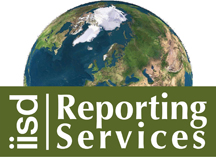News * Abou us * the ENB team * DONATE * Activities * Search * IISD RS home * IISD.org * RSS * What is RSS? * Links |
|
MEA Bulletin Guest Article
Wednesday,
19 September 2007 POVERTY AND ECOSYSTEMS: PROTOTYPE ASSESSMENT AND REPORTING METHOD – KENYA CASE STUDY By Anantha Kumar Duraiappah, Chief, Ecosystem Services Economics Unit, Division of Environmental Policy Implementation (DEPI), UNEP, Former Director, Economic Policy, IISD, and Marlene Roy, Working Group on Poverty and Environment, IISD Abstract While the Millennium Development Goals (MDGs) have set a direction for human development efforts with concrete targets and timelines and the Millennium Ecosystem Assessment (MA) has demonstrated levels of ecosystem degradation worldwide and how these are linked to human well-being, neither initiative provides the detailed road-map needed by governments. IISD developed an integrated poverty-ecosystems framework with the United Nations Environment Programme (UNEP framework) that can be used at multiple levels, but the framework required testing. To answer whether it offers the guidance that governments need to help them improve the lives of their citizens, we applied the framework to Kenya. The result is a prototype report that assesses sustainable development in Kenya, thus helping us answer our initial question and find ways to improve both the method and the report. Sen’s capabilities approach (Sen 1999) with the addition of ecological surety was used to assess human well-being in Kenya and link human development to ecosystems. To clarify poverty–ecosystem links, we identified predominant ecosystem–people interactions and related them to instrumental freedoms by pointing out some policy response options in Kenya’s ‘Poverty Reduction Strategy’ that address these interactions and support development at the same time. By using instrumental freedoms to assess the well-being of people in Kenya, we took the approach that poverty is best alleviated through the enlargement of human capabilities rather than economic growth. As a result only support-led development processes and responses were analyzed. The most effective PRSP responses for controlling land-use and land-cover change, habitat and resource consumption, demographic and economic drivers included the implementation of domestic environmental legislation including the Forestry Act, the National Environment Action Plan and others; stimulating economic facilities by subsidizing the agriculture sector and more specifically pastoralists in ASALs; empowering communities through the provision of health care, education, water, roads, energy and housing; and empowering women by mainstreaming gender. Other responses rated as effective, though not used as frequently, included domestic legislation outside the environmental sector such as enacting the Micro Finance Institutions Act; anti-corruption measures; and financial/monetary measures that include delivering micro-credit and supporting new SMEs, undertaking community-based eco-tourism and wildlife conservation. Command-and-control interventions were not used in the PRSP. Given the level of poverty in Kenya, it is doubtful that this policy response, which uses monetary penalties, would work. PRSP responses to drivers also address instrumental freedoms. The implementation of domestic environmental regulation is, for example, linked to ecological surety and social opportunities. Such synergies provide guidance to policy-makers on how to develop in more sustainable ways. For full references and a link to the full report: http://www.iisd.org/publications/pub.aspx?pno=889 |

